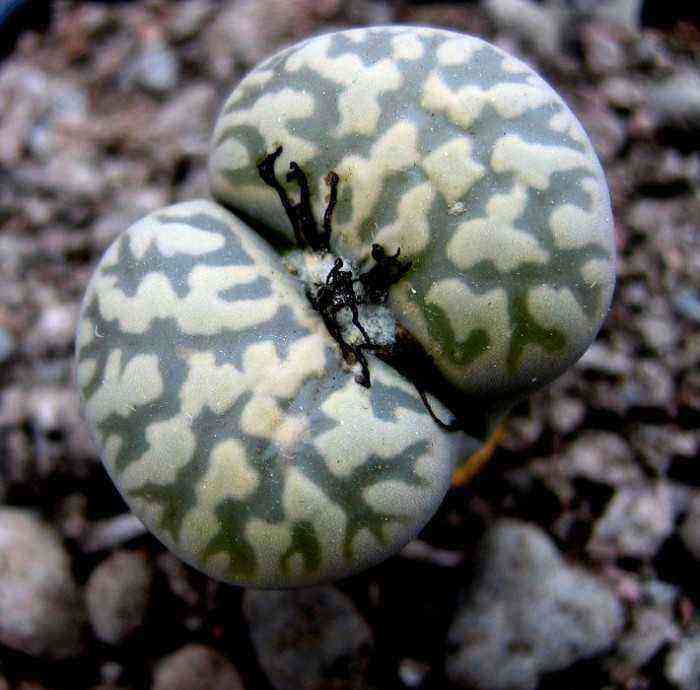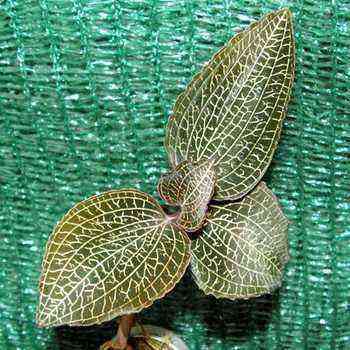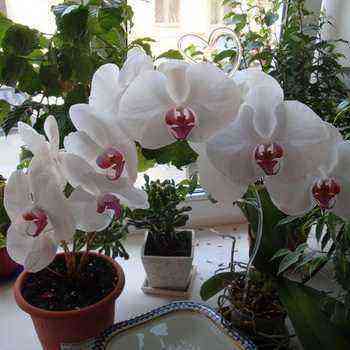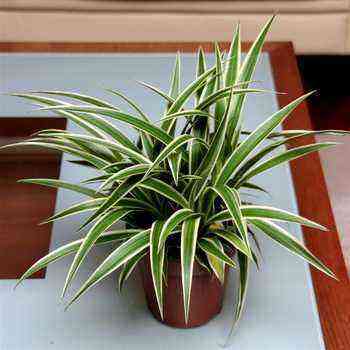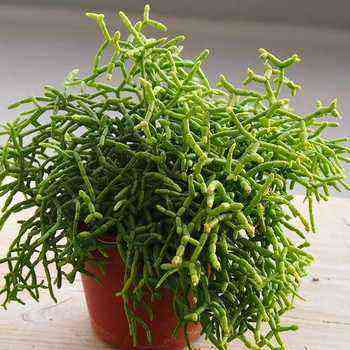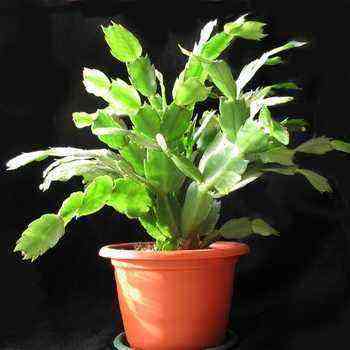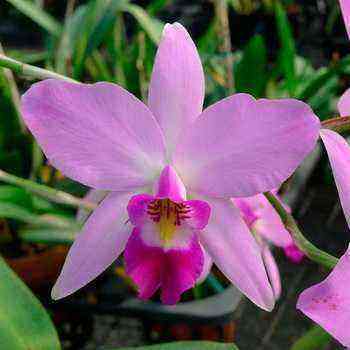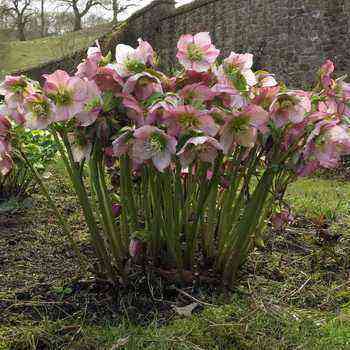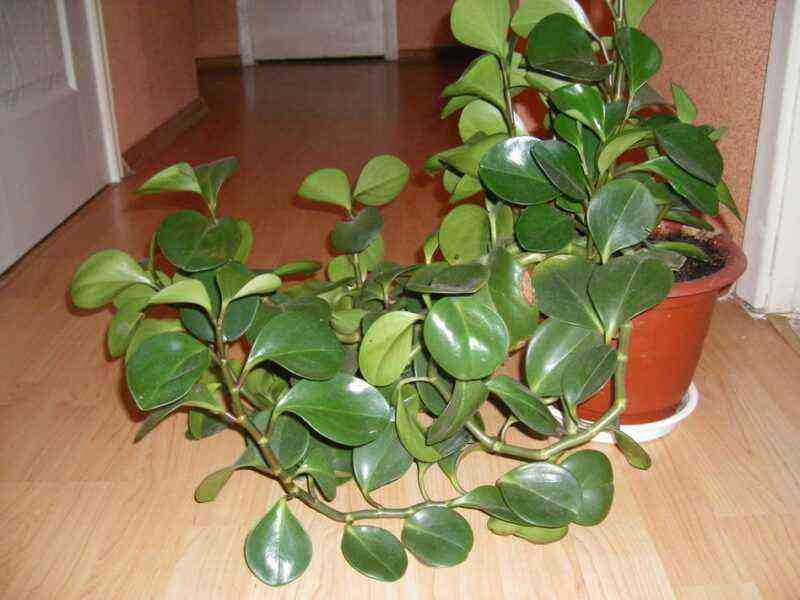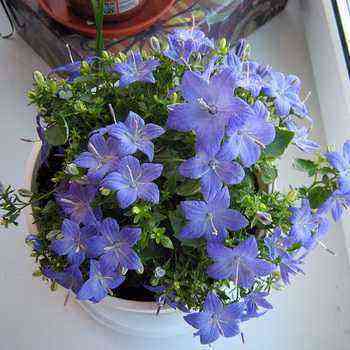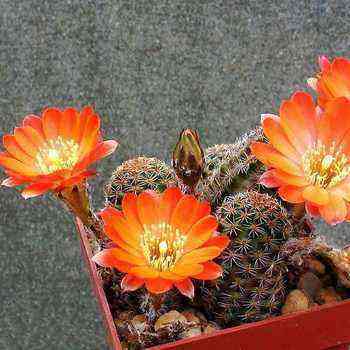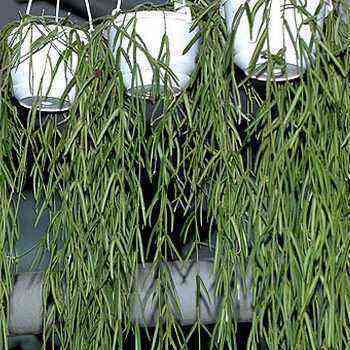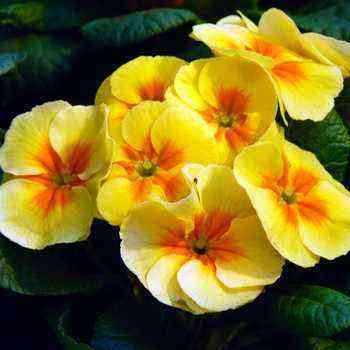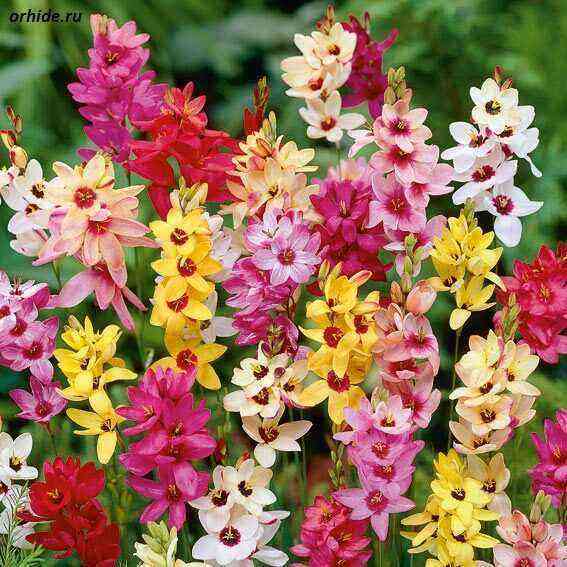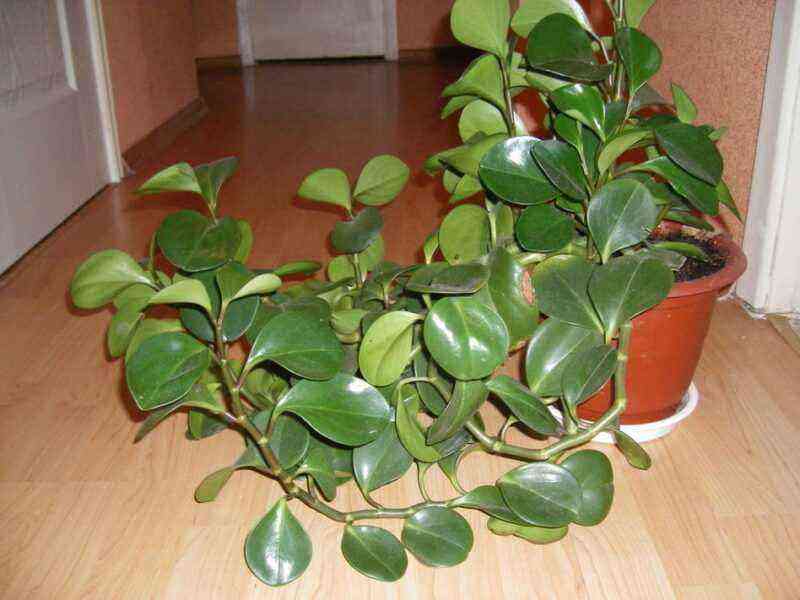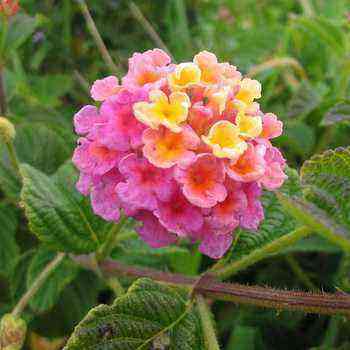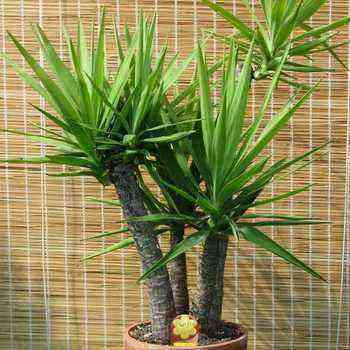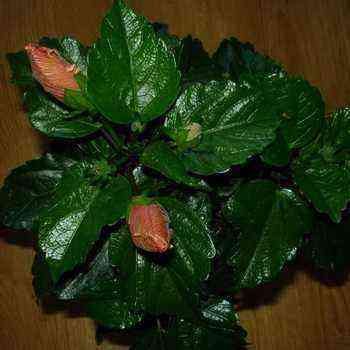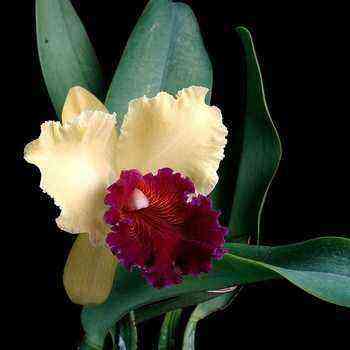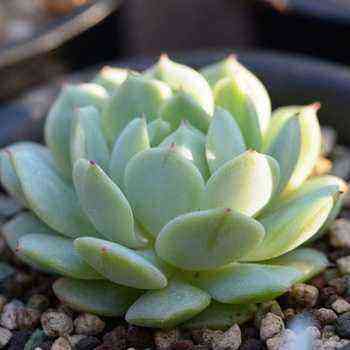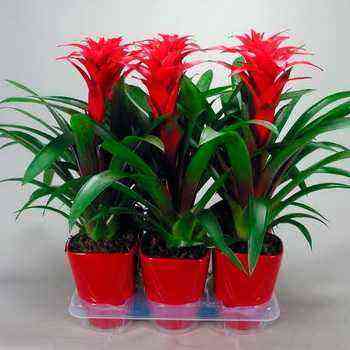 Standard flowers with variegated leaves are very difficult to grow under normal indoor conditions — they need constant warmth and high humidity. Flowers with colorful leaves and are more suitable for growing in a small garden.
Standard flowers with variegated leaves are very difficult to grow under normal indoor conditions — they need constant warmth and high humidity. Flowers with colorful leaves and are more suitable for growing in a small garden.
In this article, we will introduce you to the varieties of indoor plants with variegated leaves, such as Fittonia, Heptapleurum, Hypestes, arrowroot, Peperomia, Plectranthus, Poliscias, Scindapsus and others.
You can also see photos of flowers with variegated leaves and learn about the peculiarities of caring for home flowers with colorful leaves.
Flower with variegated leaves fittonia
There is a small-leaved dwarf Fittonia that is fairly easy to grow in your living room. It will thrive in dry air if you spray it with water occasionally.
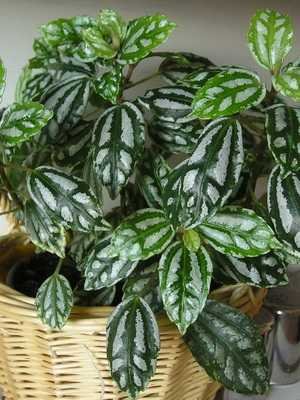

The flower with variegated leaves Fittonia has leaves with a network of veins. These veins are their distinctive feature – in F. verschaffeltii Fittonia there are pink veins, and in F. argyroneura silvery-white veins. F.s. Nana (F. a. Nana) is an easy-to-grow dwarf form.
Temperature: Moderate – at least 16 ° C in winter.
Shine: Partially shaded area without direct sunlight.
Watering: Water abundantly from spring to late fall and moderately in winter. Use lukewarm water.
Air humidity: Spray the foliage from time to time.
Transfer: Repot every two years in the spring.
Reproduction: Division of plants during transplantation. Planting rooted shoots.
Flower with colorful leaves heptapleurum
HEPTAPLEURUM is a fast growing tree plant. Pay attention to the photo of this plant with variegated leaves – it looks like a sheffler, it is quite easy to grow in the presence of warmth in winter, good lighting and humid air.
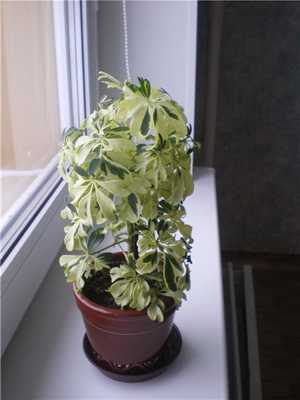
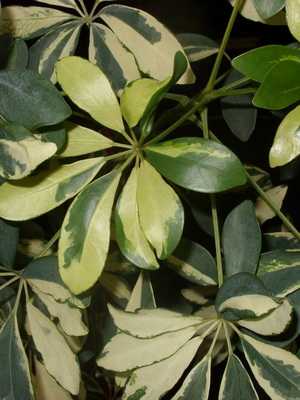
A flower with colorful leaves, heptapleurum will grow successfully as a shrub if the growth point of the main stem is removed. Leaves can fall off if conditions suddenly change.
To get an unbranched tree 2 m high, tie a tree heptapleurum (Heptapleurum arboricola) to a peg. There are varieties – Hayata (with grayish leaves), Geisha Girl (with rounded leaf tips) and Variegata (with yellow-variegated leaves).
Heptapleurum, like most indoor flowers with variegated leaves, prefers a moderate temperature. In winter, the air temperature must be at least 16 ° C.
Shine: Bright light without direct sunlight.
Watering: Water liberally from spring to fall. Water sparingly during the winter.
Air humidity: Spray the foliage frequently, wash the leaves from time to time.
Transfer: Repot in the spring annually.
Reproduction: Stem cuttings in spring or sowing seeds in spring.
Flower with multi-colored leaves gipestes and its photo
HYPOESTES are grown for its mottled leaves. In good light, their color will be bright – in a shady place, the foliage will turn completely green. This flower with colorful leaves forms small bushes, which are regularly pruned to maintain a height of 30-60 cm. After flowering, the plant sometimes falls into dormancy; in this case, reduce watering until new shoots begin to grow.
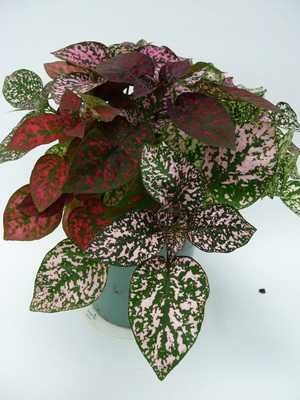
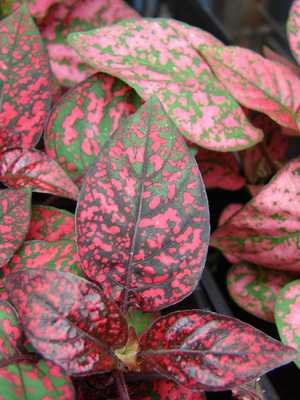
As you can see in the photo, the flower with colorful leaves of Hypoestes sanguinolenta has a blood-red hue, its foliage is covered with pale pink specks, especially expressive in the Splash variety. To maintain bushiness, pinch the tips of the shoots.
Temperature: Moderate – at least 13 ° C in winter.
Shine: Brightly lit area – some direct sunlight enhances coloration.
Watering: Keep the substrate evenly moist. Water abundantly from spring to fall — more sparsely in winter.
Air humidity: Spray the foliage frequently.
Transfer: Repot in the spring annually.
Reproduction: Sowing seeds in spring or stem cuttings in spring or summer.
Indoor flower with colorful arrowroot leaves
A distinctive feature of arrowroot is its impressive foliage with colored veins or spots on a background that can range from almost white to almost black. This indoor flower with colorful leaves rarely exceeds 20 cm in height and tends to fold and raise its leaves at night. Arrowroot is not particularly difficult to grow, but it is still not a plant for beginner growers.
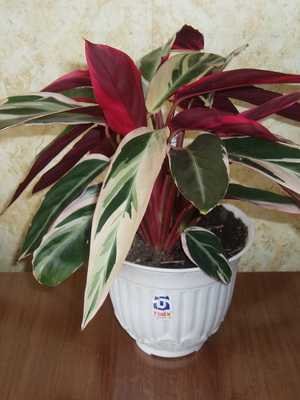
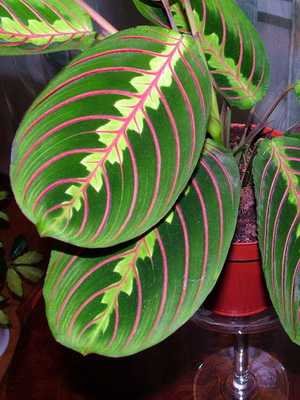
Varieties white-necked arrowroot (Maranta leuconeura) – massangeana with white veins. The red-veined variety (erythrophylla) is also sold under the name M. tricolor.
Temperature: Moderate – at least 10 ° C in winter.
Shine: Partially shaded area away from direct sunlight. Move to brightly lit area during winter.
Watering: Keep the soil moist at all times using mild lukewarm water. Reduce watering in winter.
Air humidity: Spray the foliage regularly.
Transfer: Repot every two years in the spring.
Reproduction: Division of plants during transplantation.
Read more about the arrowroot flower …
Home flower with colorful peperomia leaves
Peperomias grow slowly and are suitable for places where space is limited. The inflorescence is a thin, upright spike covered with tiny greenish flowers. There are several ampelous species, but bushy ones with various shapes and colors of leaves are more popular. It is not difficult to grow peperomias.
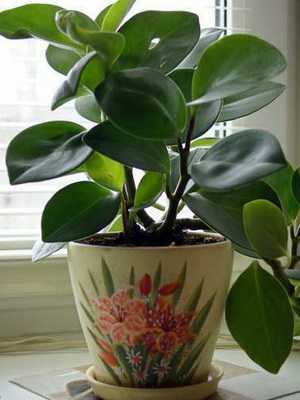
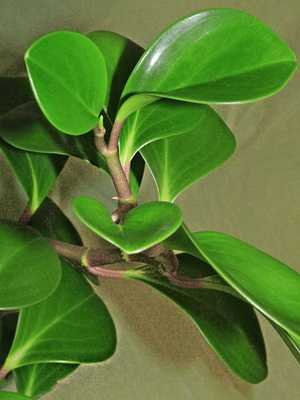
У wrinkled peperomia (Peperomia caperata) corrugated leaves 2,5 cm wide; P. ivy (P. hederaefolia) has wavy leaves 5 cm wide; P. magnoliaefolia Variegata has variegated waxy leaves 5 cm in size.
Temperature: Moderate – at least 10 ° C in winter.
Shine: Bright light or partial shade without direct sunlight.
Watering: Allow the soil to dry out to some extent between waterings – water very sparsely during winter.
Air humidity: Spray foliage from time to time in summer and never in winter.
Transfer: Repot in the spring only if necessary.
Reproduction: Stem cuttings in spring.
Indoor flowers with colorful leaves plectrantus
Plectrantus looks more like a small simple Coleus with drooping stems. These indoor flowers with colorful leaves are not very popular, although they have many good qualities. Plectrantus can grow in dry air, it withstands temporary dryness of the soil, grows quickly, and will even bloom sometimes. From time to time, pinch the tips of the shoots so that the plants are thick.

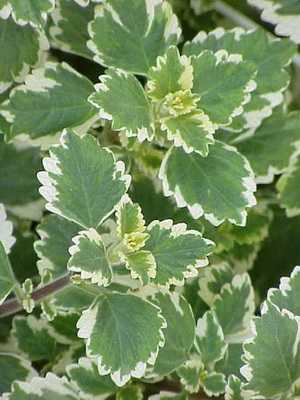
Pleckrantus Ertendal (Plectranthus oertendahlii) has colored leaves 2,5 cm wide and pink-lilac flowers 2,5 cm long. The largest leaves are white-bordered coleus plectrantus (P. coleoides marginatus).
Temperature: Moderate – at least 10 ° C in winter.
Shine: Bright light or partial shade without direct sunlight.
Watering: Keep the soil moist at all times. Reduce watering in winter.
Air humidity: Spray the foliage from time to time.
Transfer: Repot every two years in the spring.
Reproduction: Stem cuttings in spring or summer.
Read more about the plectrantus flower …
Plant with colorful leaves polisias and his photo
The twisted stems and attractive foliage of the polisias give the plants an oriental look. However, they are not popular because they are expensive and easily shed their leaves if their needs are not fully met. The most common is the Balfour polisias.
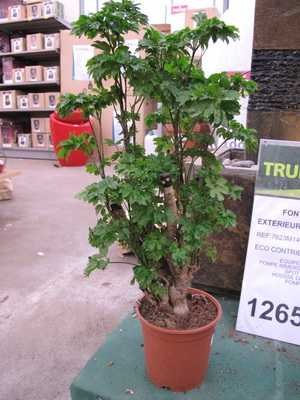

Pay attention to the photo of this plant with colorful leaves – Polyscias balfouriana has gray-spotted leaves 8 cm wide; the leaves of the Pennockii variety have yellow veins. Leaves of P. shrub (P fruticosa) 20 cm long.
Temperature: Moderate – at least 16 ° C in winter.
Shine: Bright light without direct sunlight.
Watering: Water sparingly from spring to fall – water sparingly in winter.
Air humidity: Spray the foliage frequently.
Transfer: Repot every two years in the spring.
Reproduction: Complicated. Stem cuttings in spring – use hormones for rooting and heating the substrate.
Flower with variegated leaves scindapsus
SCINDAPSUS is an easy-to-grow plant with leaves with yellow or white spots. It can be called golden scindapsus (Scindapsus aureus) and golden pothos (Pothos) in garden centers, and botanists have adopted the name golden epipremnum (Epipremnum aureus).

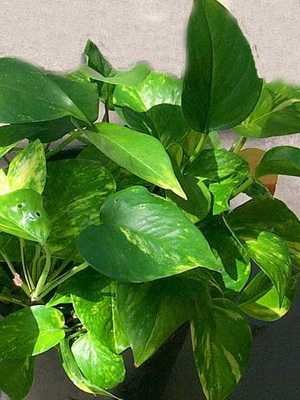
Scindapsus, or golden epipremnum (Scindapsus, or Epipremnum aureus), – liana or ampelous plant; a moss stick is an ideal support. Stems can reach 2 m or more.
Temperature: Moderate – at least 10-13 ° C in winter.
Shine: A well-lit place with no sun rays. Variegation disappears in poor lighting conditions.
Watering: Water liberally from spring to fall. Water sparingly during the winter. Humidity: Spray foliage frequently.
Transfer: Replant if necessary in the spring.
Reproduction: Stem cuttings in spring – use hormones for rooting. Keep in the dark until it takes root.
Houseplant with variegated leaves
The ground plant is a complex genus that includes flowering species, succulent species, and false ivy like vines. Like true ivy, they have lobed leaves and stems that hang or form on a support, but their lobes are more pointed and fleshy. They grow better in dry air than true ivy.

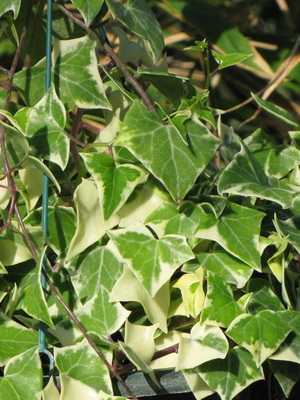
У large-reed groundwort (Senecio marcroglossus variegatus) leaves with yellow edges on stems up to 3 m long.K. shiny, or mikaniform (S. mikanioides) can also reach a length of 3 m.
Temperature: Moderate – at least 10 ° C in winter.
Shine: Bright light – some direct sunlight is beneficial in winter.
Watering: Keep the soil moist all the time – reduce watering in winter.
Air humidity: Spray the foliage from time to time.
Transfer: Repot in late spring every two years.
Reproduction: Stem cuttings in spring or summer.
Home flower with colorful leaves of sansevieria
Three-striped sansevieria is the most popular type of houseplants with colorful leaves. This is a very stable (unpretentious) plant – vertical succulent leaves withstand drafts, dry air, bright sun, thick shade and direct sunlight. In good conditions, it produces inflorescences with fragrant small white flowers.


Sansevieria three-lane (Sansevieria trifasciata) – a species with completely green leaves 30 cm-1 m high; its variety laurentii is variegated, Golden hahnii is a dwarf 15 cm high.
Temperature: Moderate – at least 10 ° C in winter.
Shine: Bright light with some sunlight, but can grow in shade.
Watering: Water sparingly from spring to fall; once every 1-2 months in winter.
Air humidity: Spraying is not necessary.
Transfer: Rarely required – repot if pot is damaged.
Reproduction: Separate the offspring at the base by cutting them off and let them dry before composting.
Flower with variegated sheffler leaves
Unfortunately, shefflera does not bloom under indoor conditions. She has finger-like glossy leaves arranged in rays, like the needles of an umbrella. It is not difficult for a sheffler to grow.

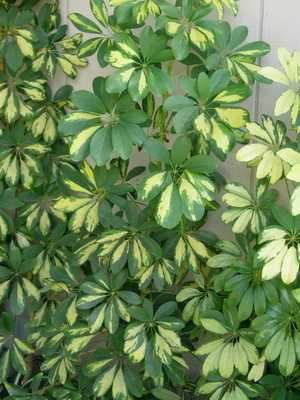
Young shefflera radiant (Schefflera actinophylla) is an attractive shrub, and in mature age a tree 1,8-2,5 m high. Sh. finger (S. digitata) is smaller. Sh. Eight-leafed (S.octophyllum) leaves with distinct veins.
Temperature: Moderate – at least 13 ° C in winter. Avoid temperatures above 21 ° C whenever possible.
Shine: A brightly lit area away from direct sunlight.
Watering: Water liberally from spring to fall. Water sparingly during the winter.
Air humidity: Spray the foliage frequently.
Transfer: Repot every two years in the spring.
Reproduction: Complicated. Stem cuttings in summer. Use rooting hormones and substrate warming.
Indoor plant with colorful leaves of nolin
Nolina is grown as a tall, solitary plant that does not require much attention. The bulging, bulb-like base accumulates water, so temporary drying out of the soil will not harm it. She has a lush “tail” of long, belt-like leaves. Nolina is sometimes sold under the name Beaucarnea recurvata.
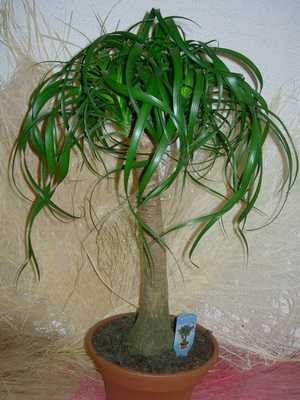
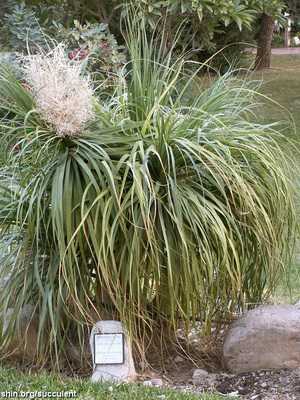
There is one type on sale – nolina tuberculata (Nolina tuberculata). It grows slowly, but over time, the trunk will reach a height of 2 m or more, and the base of the trunk will be swollen, like a huge bulb.
Temperature: Moderate – at least 10 ° C in winter.
Shine: Brightly lit areas – Some sun exposure is helpful.
Watering: Water thoroughly, then let the soil dry moderately. Avoid waterlogging.
Air humidity: Spraying is not necessary.
Transfer: Replant if necessary in the spring.
Reproduction: Separate and plant offspring during transplant. Not easy – it’s better to buy new plants.
Yucca plant
Ripe yucca is a wonderful false palm tree for a hallway or large room. She will need a deep, well-drained container that can be moved outdoors in summer and in an unheated and well-lit area in winter. White bell-shaped flowers may appear after a few years.
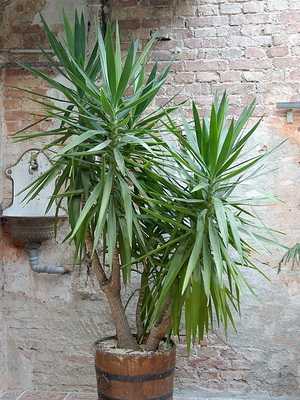

A tree trunk 1-1,5 m high bears a rosette of long leathery leaves. Yucca elephantipes is safer than Yaloifolia with sharp xiphoid leaves.
Temperature: Moderate – Keep cool during winter (minimum 7 ° C).
Shine: Pick the brightest spot you have.
Watering: Water liberally from spring to fall. Water sparingly during the winter.
Air humidity: Spraying is not necessary.
Transfer: Repot every two years in the spring.
Reproduction: Separate and plant offspring or root cuttings from stem sections.
Flower with variegated radermacher leaves
The Radermacher is grown as a single indoor tree. It has large, compound leaves that bear shiny, deep-veined leaves with long tapering tips. Central heating is not a problem when growing it because it tolerates dry air well.
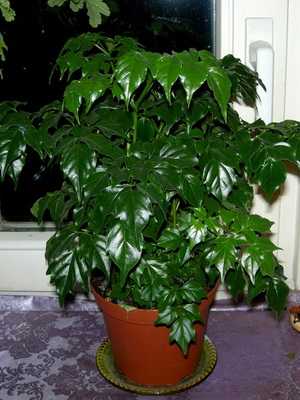
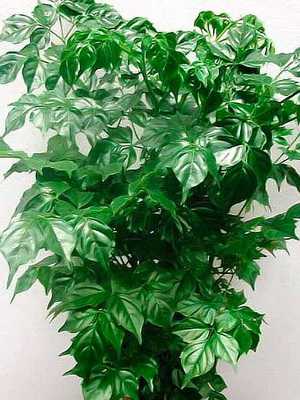
A Radermacher grown as a houseplant may be labeled as Radermachera sinica, R. Danielle, or Stereospermum suaveolens. There is a variegated form.
Temperature: Moderate – at least 10-13 ° C in winter.
Shine: Brightly lit areas, but protect from the midday summer sun.
Watering: Keep the soil moist at all times – avoid waterlogging.
Air humidity: Spraying is not necessary.
Transfer: Replant if necessary in the spring.
Reproduction: Stem cuttings in summer.

